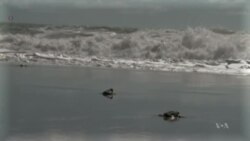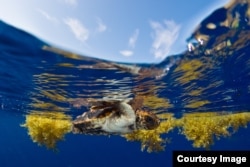Satellite tracking devices attached to young sea turtles have provided new information on the so-called ‘lost years’ of this endangered species.
As soon as the hatchlings emerge from their sandy nest, they scurry down the beach to the ocean and disappear into the deep for many years before returning to the beach to mate.
Satellite technology catches up
The young turtles are tiny and always on the move, making them almost impossible to track.
A new study, published in the journal Proceedings of the Royal Society B, is the first to report their early behavior and movement.
Lead author Kate Mansfield, a marine biologist at the University of Central Florida, credits small remote sensing devices.
“Because they were solar powered, they did not require huge batteries in order to communicate with overhead satellites,” she explained. “So we were able to use much smaller tags that had become available [to put] on smaller turtles.”
Mansfield and her colleagues glued tags onto 17 baby loggerheads and released them on Florida’s Atlantic coast. The team tracked the turtles through the open ocean for up to 220 days. They expected that the turtles would remain at the sea surface, and, based on information from the satellite tags, they were able to validate that belief.
Sargasso Sea habitat
Other satellite data, Mansfield says, provided unexpected information about the movement of the turtles in the large circular current of the North Atlantic. About half of the group moved out of the current into the Sargasso Sea at its center. “That was pretty exciting, and it shows that the turtles have a little bit more variability in their movement patterns than this original idea of this large circular migration, one-way unidirectional migration around the Atlantic,” says Mansfield.
The Sargasso Sea turns out to be a popular refuge with a floating seaweed buffet where the young loggerheads can forage and find shelter.
The turtles tap the thermal benefit of the warmer surface water and eat the crustaceans and other small marine organisms that live on the mats of algae. Mansfield says identifying critical habitats, like the Sargasso Sea, is an important step for wildlife protection.
Kate Mansfield is working on expanding her research beyond loggerheads in the Atlantic to monitor the behavior of young turtles in other ocean basins. Sea turtles are endangered or threatened in every ocean system in the world.
As soon as the hatchlings emerge from their sandy nest, they scurry down the beach to the ocean and disappear into the deep for many years before returning to the beach to mate.
Satellite technology catches up
The young turtles are tiny and always on the move, making them almost impossible to track.
A new study, published in the journal Proceedings of the Royal Society B, is the first to report their early behavior and movement.
Lead author Kate Mansfield, a marine biologist at the University of Central Florida, credits small remote sensing devices.
“Because they were solar powered, they did not require huge batteries in order to communicate with overhead satellites,” she explained. “So we were able to use much smaller tags that had become available [to put] on smaller turtles.”
Mansfield and her colleagues glued tags onto 17 baby loggerheads and released them on Florida’s Atlantic coast. The team tracked the turtles through the open ocean for up to 220 days. They expected that the turtles would remain at the sea surface, and, based on information from the satellite tags, they were able to validate that belief.
Sargasso Sea habitat
Other satellite data, Mansfield says, provided unexpected information about the movement of the turtles in the large circular current of the North Atlantic. About half of the group moved out of the current into the Sargasso Sea at its center. “That was pretty exciting, and it shows that the turtles have a little bit more variability in their movement patterns than this original idea of this large circular migration, one-way unidirectional migration around the Atlantic,” says Mansfield.
The Sargasso Sea turns out to be a popular refuge with a floating seaweed buffet where the young loggerheads can forage and find shelter.
The turtles tap the thermal benefit of the warmer surface water and eat the crustaceans and other small marine organisms that live on the mats of algae. Mansfield says identifying critical habitats, like the Sargasso Sea, is an important step for wildlife protection.
Kate Mansfield is working on expanding her research beyond loggerheads in the Atlantic to monitor the behavior of young turtles in other ocean basins. Sea turtles are endangered or threatened in every ocean system in the world.










